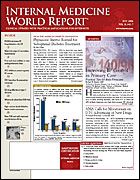Publication
Article
Internal Medicine World Report
Paced Breathing May Attenuate White Coat Hypertension
Paced Breathing May Attenuate White Coat Hypertension
SAN FRANCISCO—Fifteen minutes a day of paced breathing guided by a device
that monitors respiration may mitigate the “white coat effect” and reduce home blood
pressure (BP) measurement levels, according to data presented at the 20th American
Society of Hypertension annual meeting. About 80% of the white coat effect was
attenuated with device-guided breathing. “These findings are encouraging, especially
since this condition [white coat hypertension] does not usually respond to drug
treatment,” said William J. Elliott, MD, PhD, of Rush University Medical Center,
Chicago. The white coat effect—a substantial difference between home and office BP—is
present in up to 25% of patients with hypertension. A total of 7 studies have
demonstrated that a device that monitors respiration continuously and guides the
breathing pattern through a series of tones can significantly lower office BP readings.
The device, RESPaRATE, consists of a control box that contains a microprocessor,
a belt-type respiration sensor, and headphones. The device analyzes the breathing
rate and creates tones for inhalation and exhalation to which the patient synchronizes
his or her breathing. Dr Elliott pooled data from 6 studies that included 239 patients who were randomized to device-guided breathing for 8weeks or a control intervention (relaxation
music played by a cassette player and/or home BP monitoring). Most patients were
taking antihypertensive drug therapy. The difference between home and office
BP measurements at baseline was 26/16 mm Hg in the treatment group and 24/15
mm Hg in the control group. Active treatment significantly reduced home BP compared with both baseline and the control. The change was —3.2/–2.0 mm Hg in the treatment group
(P <.05) and —1.3/–0.6 mm Hg in the control group (P <.01). The reduction was most marked in
patients who had an initial home BP >135/85 mm Hg. For those with an initial home BP >128/76 mm Hg, paced breathing reduced home BP readings by diastolic BP), whereas no significant
change was observed in either parameter in the control patients. The effects of paced breathing were independent of medication use. No adverse reactions were reported. The reductions in BP and the mitigation of the white coat effect are consistent with decreased sympathetic activity, said
Dr Elliott. Inappropriately high sympathetic nervous outflow from the central nervous system is thought to be important in the pathophysiology of hypertension. Slow breathing may reduce sympathetic nerve traffic, resulting in arteriolar dilatation.—W.K.






